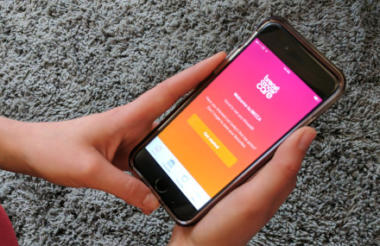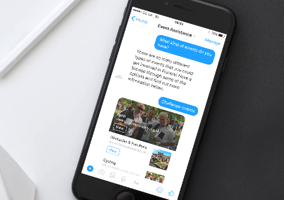In April 2016 Breast Cancer Care entered Fuse, CAST’s three-month digital accelerator programme. The charity wanted to create a new product that supported women through their breast cancer treatment. They teamed up with innovation and design studio, Super Being Labs, and have since worked in partnership to develop BECCA, the Breast Cancer Care app.
BECCA is the one-stop-shop for hints and tips to help someone feel better after treatment for primary breast cancer. Populated with over 300 flash cards, BECCA links someone to further content from a variety of trusted sources. As we write this it has over 8,500 users and 4.9* ratings in the iTunes and Android app stores. And that’s grown by 1,000 users in just the last two months alone.
In December the Big Lottery Fund committed £655k of National Lottery funding to further develop BECCA by introducing machine learning capabilities into the app, and scale it to reach and support thousands more women who are affected by the disease.
CAST’s top three learnings
1. Ready access to users is key to a fast, effective design process
Breast Cancer Care was well placed to conduct user research - often one of the most time-consuming (but critical) parts of any product ‘discovery’ phase. They had a self-selecting group of over 40 women who had volunteered to be ‘digital champions’: available for research and interviews, and for receiving early access to new digital initiatives. They were the main source of our one-to-one research interviews, and we took the opportunities of existing group meetings to share ideas and get input from them throughout the process.
2. Understand existing behaviours and context
This is true for all product/service design. From our user interviews, we mapped the journey a breast cancer patient experiences through their diagnosis and treatment. This included everything from appointments with medical professionals right through to their emotional state at each stage. We realised the service needed to address the time after the final formal appointment - once the survivor is given the ‘all clear’ and their appointments end, they often find themselves at a loss as to what to do and rebuild their life. This insight defined which ideas we should prototype.
3. Individual leads need organisational support
Being a ‘product owner’ means means holding the vision for the product, having the authority to make decisions and taking ownership of the whole design process, from research to prototyping and liaising with the development team. This can be a huge amount for one person to learn and lead in a very short space of time. So Fuse builds a team of design and development experts around a ‘fusilier’ from the charity, who is trained in ‘product ownership’. Equally this team works closely with the senior sponsors to ensure the fusilier is supported, practically and emotionally, during the product development process. And this has to continue long after they leave the accelerator. BECCA’s advisory panel has helped Krissie and the team maintain energy and momentum since finishing Fuse.
Four key learnings from the being a product owner
Krissie Barrick, Breast Cancer Care’s digital innovation manager, reflects on her experience.
1. Learn from your users
At the start of this process we couldn’t have told you that BECCA would become a content-based app. We couldn’t have known either, what content people wanted. This all had to be tested, which meant taking risks. An essential part of the process here is creating and nurturing open communication with your users — workshops, phone calls, emails and surveys are things you can offer on an ongoing basis. Two of the simplest and most important things to find out are how they would describe the app to another person and what triggers them to open it. BECCA user’s consistently describe the app as a ‘pocket guide’ and ‘like a friend’:
“BECCA is like a friend. It reminds me that I’m not alone, and that it’s ok to be worried sometimes. It’s a safe place where I can relate to everything I read in some way. It helps me motivate myself to do things, but if I can’t, it lets me know that’s ok too.”
2. You can respond on a budget
Learning is good. Responding to this is vital. Without funding, there is little you can do in terms of jazzy technology. We focused on what we could do to make BECCA as useful as possible with internal budgets while applying for funding. You do not require impressive technology to create good content, you need people. We adjusted our existing content producer’s role in the digital team to work on BECCA two days a week. We had a rolling internship to support the sourcing and curation of content. We regularly ask for hints and tips from our fantastic community on our forum and social channels and we have a simple BECCA Content Creator (made using Typeform) which we circulate to bloggers. Voila! We have content.
3. Personify the product
Trust your instincts and have faith. You are the product owner, which makes you the face of it. I sometimes feel like I am the walking, talking, breathing version of BECCA. If you really believe in your product, other people will too. You need to stick with it through thick and thin and be proud to represent it, even in the face of knock-backs and adversity. We had more than a few funding bid rejections, and twice we made it to the final stage (of three stages) in a six-month application process. With each knock-back we continued to refine the product itself and develop its roadmap. I now see that time and work as a blessing as it gave us lots of thinking space about where BECCA might go, and an opportunity to horizon scan for interesting technologies we could tap into to improve the app. By the time we wrote the BLF application we also had tonnes of evidence to support the need for the investment.
4. Build a roadmap
For our users, the value of the app is in its content. And a necessity became clear that we could count on: improving the relevance of the content for each individual would significantly improve their experience of the app.
We had had lots of conversations with BECCA users, and here are some of the snippets of what we heard, which represent a pattern we could respond to:
- “I’ve been using it for a while so would like to see either more ideas and new information.”
- “Obviously there's stuff that doesn’t apply to me at all, a lot of it is very useful though!”
- “The beauty and fashion don’t relate to me. Mostly fatigue. And I needed information about the symptoms post radiotherapy.”
- “I don’t like the get a hobby cards”.
- “I really like the hobby and activity suggestions”
We formed a plan that would enable ongoing commitment to our users and wasn’t confined to features — therefore enabling room for manoeuvre if changes needed to be made within the app itself. The plan involves introducing machine learning technology into BECCA to automate the content sourcing process. We are working with Skim.it, whose technology essentially mimics the work we are doing by scanning trusted sources across the net and creating cards which we can check, edit and upload. It will also discover any new bloggers out there who are blogging about their experience of breast cancer, something we’ve found to be very powerful in making others feel less isolated and comforted. By enhancing and expanding the selection of content in BECCA we can make sure we have the most diverse and up-to-date bank of content on breast cancer available. From there we can introduce algorithms in to the app to respond to a user’s cues and start delivering information to them that they have a preference for, and demoting information that is irrelevant to them.
By 2020, BECCA hopes to reach 36,000 women affected by breast cancer. You can read more and download the app here.
To date, Fuse has helped twelve established charities create digital products and services that are user-led and test-driven. CAST will soon be recruiting small charities for this year’s Fuse. Sign up to our newsletter to be the first to hear about this.
Related articles












